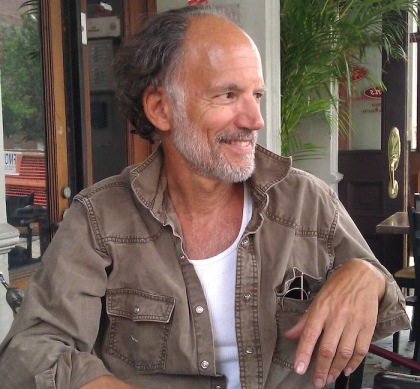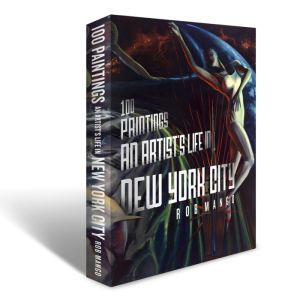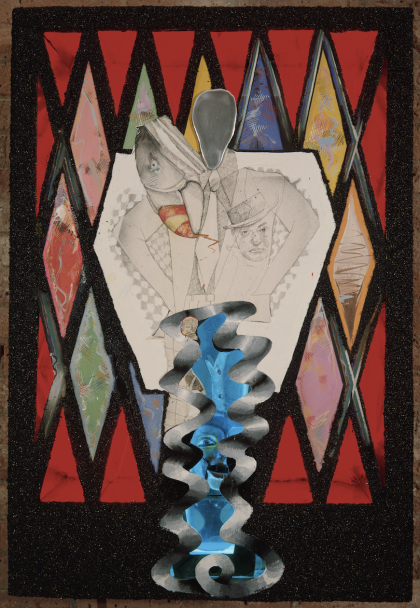When Hollywood Royalty Came to Visit

 When I learned that artist Rob Mango—whose gallery on Duane Park is a Tribeca institution—had a new book, 100 Paintings: An Artist’s Life in New York City, I assumed it was focused on his art. But it’s so much more: a memoir about his own life, and a vivid account of the birth of Tribeca as a residential neighborhood. He agreed to let me run several excerpts, along with the corresponding paintings. The book is available at Rob’s gallery at 178 Duane as well as robmango.com, Amazon, and Barnes & Noble.
When I learned that artist Rob Mango—whose gallery on Duane Park is a Tribeca institution—had a new book, 100 Paintings: An Artist’s Life in New York City, I assumed it was focused on his art. But it’s so much more: a memoir about his own life, and a vivid account of the birth of Tribeca as a residential neighborhood. He agreed to let me run several excerpts, along with the corresponding paintings. The book is available at Rob’s gallery at 178 Duane as well as robmango.com, Amazon, and Barnes & Noble.
Also! A show of Rob’s work is up now at Elga Wimmer Gallery.
Previously in this series:
••• Artist Rob Mango on Tribeca’s Pioneer Days
••• Rob Mango on Tribeca Becoming Tribeca
Early one May evening in 1981, gold spring light was flooding into my night-watchman quarters in Tribeca as I worked on a motorized kinetic 3-D construction entitled The Comedian. My work table was a few feet from the door and I glanced up as a decidedly Italian looking man peered in. He wore a casual three-piece coral, blue and white pinstriped suit with wide lapels; an open, white silk disco-collared shirt; and boasted a manicured black goatee beard. A wide-eyed woman with a sweet, youthful smile was just behind him, radiating unassuming country shyness. As was my custom, I beckoned them to enter.
I loved his film Mean Streets, but I had never met Martin Scorsese. When he and his wife Isabella Rossellini stepped in, I had no idea to whom I was speaking. All I knew was that here was a smart, fast-talking guy with great taste in fashion, women and, apparently, art. He was very intrigued by my work.
After he introduced himself and Isabella, and we discussed his films, he told me that he developed his fantasy of inner-city, Italian male hierarchical behavior by looking out his apartment window onto the provocative streets of Little Italy. He was less than healthy as a boy and spent his time observing, thinking and plotting. I had never heard a person speak so fast and so coherently in numerous directions simultaneously. His visit may have been one of those moments when a guy seizes a risk-free opportunity to expound, to impress female company.
Marty was not reluctant to monopolize the conversation and that was fine with me. He verbally diagrammed all the possible outcomes and variations for my kinetic sculpture, which lay disassembled before us, while effectively comparing what he saw to various templates of suspense he used in his film plots. Marty was editing The King of Comedy in the triplex penthouse complex of the building we were standing in. The coincidence of his film title and my assemblage’s name made for a continuum of quips when we encountered one another. He lived on one floor and edited his movies on another. In his living space were rooms full of cool suits on rolling racks; I have never seen a more fabulous wardrobe. Marty is a night owl and I would hear from him occasionally in the early morning hours because he smelled a gas leak or just wanted someone to talk to.
In Scorsese World, unexpected things were always about to happen and did happen. He called once and asked me if I “would get rid of” a guy who was ringing his buzzer, wanting to speak with Isabella’s visiting sister. Before heading down, I went over to speak with Isabella. She told me the man at the front door came from Italy seeking his wife (her sister), who had fled his wrath. I reviewed my options: be diplomatic or engage a tough, Sicilian, south side Chicago persona—which would not be an act. I dismissed the interloper diplomatically more than once, but in the end resorted to the latter approach. Isabella was relieved, and she and her sister expressed their appreciation with hugs, tears and a kiss. Not something a man will ever forget.
A year later Marty called me and said his mother-in-law, Ingrid Bergman, was paying him a visit. He asked if I could make sure she was brought up to the apartment unaccosted—and also, she wanted to speak with me. Me?
I waited on the curb in the rain with an umbrella and escorted her from the limo into the elevator. We rode in silence—I was absorbing her majestic presence—and then, before exiting the elevator, she paused. She had on a very feminine, aquamarine wool hat with a broad, soft brim. A mauve lace veil hung elegantly in front of her face, allowing some anonymity. She lifted her veil and asked me, in that famous voice, “Are you the young man who assisted my daughter?”
I cannot remember breathing. Her elegance was stultifying. She had the same sweet smile of her daughters. The same smile that graced countless films in which she appeared. She possessed an aura that was palpable, a visible radiance. It made me weak. She thanked me. Her smile was paralyzing, as disarming a gesture as I had ever known.
Below: The Comedian (1983). Black silica sand, internal red neon, motorized sculpted head, pen and ink, gouache under clear plexiglass box. 40 x 24 x 8 in. Collection of the artist. Click to enlarge.
Update: Comments have been turned off due to spam. To have them turned back on, email tribecacitizen@gmail.com.














Great story and vividly told.
man, this is great thanks
Jeez, I consider myself an aficionado of ‘dish’, but I did not know that MS was once married to IR. Good work R Mango ! TALAN